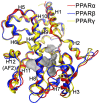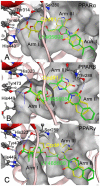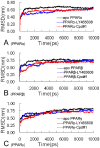Scaffold-based pan-agonist design for the PPARα, PPARβ and PPARγ receptors
- PMID: 23119024
- PMCID: PMC3485212
- DOI: 10.1371/journal.pone.0048453
Scaffold-based pan-agonist design for the PPARα, PPARβ and PPARγ receptors
Abstract
As important members of nuclear receptor superfamily, Peroxisome proliferator-activated receptors (PPAR) play essential roles in regulating cellular differentiation, development, metabolism, and tumorigenesis of higher organisms. The PPAR receptors have 3 identified subtypes: PPARα, PPARβ and PPARγ, all of which have been treated as attractive targets for developing drugs to treat type 2 diabetes. Due to the undesirable side-effects, many PPAR agonists including PPARα/γ and PPARβ/γ dual agonists are stopped by US FDA in the clinical trials. An alternative strategy is to design novel pan-agonist that can simultaneously activate PPARα, PPARβ and PPARγ. Under such an idea, in the current study we adopted the core hopping algorithm and glide docking procedure to generate 7 novel compounds based on a typical PPAR pan-agonist LY465608. It was observed by the docking procedures and molecular dynamics simulations that the compounds generated by the core hopping and glide docking not only possessed the similar functions as the original LY465608 compound to activate PPARα, PPARβ and PPARγ receptors, but also had more favorable conformation for binding to the PPAR receptors. The additional absorption, distribution, metabolism and excretion (ADME) predictions showed that the 7 compounds (especially Cpd#1) hold high potential to be novel lead compounds for the PPAR pan-agonist. Our findings can provide a new strategy or useful insights for designing the effective pan-agonists against the type 2 diabetes.
Conflict of interest statement
Figures




Similar articles
-
Design novel dual agonists for treating type-2 diabetes by targeting peroxisome proliferator-activated receptors with core hopping approach.PLoS One. 2012;7(6):e38546. doi: 10.1371/journal.pone.0038546. Epub 2012 Jun 7. PLoS One. 2012. PMID: 22685582 Free PMC article.
-
Identification of novel PPARα/γ dual agonists by virtual screening, ADMET prediction and molecular dynamics simulations.J Biomol Struct Dyn. 2018 Aug;36(11):2988-3002. doi: 10.1080/07391102.2017.1373706. Epub 2017 Oct 5. J Biomol Struct Dyn. 2018. PMID: 28853334
-
Find novel dual-agonist drugs for treating type 2 diabetes by means of cheminformatics.Drug Des Devel Ther. 2013 Apr 8;7:279-88. doi: 10.2147/DDDT.S42113. Print 2013. Drug Des Devel Ther. 2013. PMID: 23630413 Free PMC article.
-
PPAR dual agonists: are they opening Pandora's Box?Pharmacol Res. 2007 Aug;56(2):91-8. doi: 10.1016/j.phrs.2007.03.002. Epub 2007 Mar 14. Pharmacol Res. 2007. PMID: 17428674 Review.
-
Novel approach to treat insulin resistance, type 2 diabetes, and the metabolic syndrome: simultaneous activation of PPARalpha, PPARgamma, and PPARdelta.Curr Diabetes Rev. 2005 Aug;1(3):299-307. doi: 10.2174/157339905774574365. Curr Diabetes Rev. 2005. PMID: 18220606 Review.
Cited by
-
Role of an indole-thiazolidine molecule PPAR pan-agonist and COX inhibitor on inflammation and microcirculatory damage in acute gastric lesions.PLoS One. 2013 Oct 4;8(10):e76894. doi: 10.1371/journal.pone.0076894. eCollection 2013. PLoS One. 2013. PMID: 24124600 Free PMC article.
-
Design, synthesis, biological activity and molecular dynamics studies of specific protein tyrosine phosphatase 1B inhibitors over SHP-2.Int J Mol Sci. 2013 Jun 17;14(6):12661-74. doi: 10.3390/ijms140612661. Int J Mol Sci. 2013. PMID: 23774838 Free PMC article.
-
To Probe Full and Partial Activation of Human Peroxisome Proliferator-Activated Receptors by Pan-Agonist Chiglitazar Using Molecular Dynamics Simulations.PPAR Res. 2020 Apr 1;2020:5314187. doi: 10.1155/2020/5314187. eCollection 2020. PPAR Res. 2020. PMID: 32308671 Free PMC article.
-
Molecular docking of antidiabetic molecules of libas (Spondias pinnata) fruit and prediction of their pharmacokinetic properties.In Silico Pharmacol. 2024 Jun 14;12(1):57. doi: 10.1007/s40203-024-00230-3. eCollection 2024. In Silico Pharmacol. 2024. PMID: 38882504 Free PMC article.
References
-
- Wild S, Roglic G, Green A, Sicree R, King H (2004) Global prevalence of diabetes: estimates for the year 2000 and projections for 2030. Diabetes Care 27: 1047–1053. - PubMed
-
- Zimmet P, Shaw J, Alberti KG (2003) Preventing Type 2 diabetes and the dysmetabolic syndrome in the real world: a realistic view. Diabet Med 20: 693–702. - PubMed
-
- Berger J, Moller DE (2002) The mechanisms of action of PPARs. Annu Rev Med 53: 409–435. - PubMed
-
- Berger JP, Akiyama TE, Meinke PT (2005) PPARs: therapeutic targets for metabolic disease. Trends Pharmacol Sci 26: 244–251. - PubMed
-
- Escher P, Braissant O, Basu-Modak S, Michalik L, Wahli W, et al. (2001) Rat PPARs: quantitative analysis in adult rat tissues and regulation in fasting and refeeding. Endocrinology 142: 4195–4202. - PubMed
Publication types
MeSH terms
Substances
LinkOut - more resources
Full Text Sources
Research Materials

